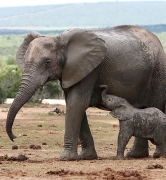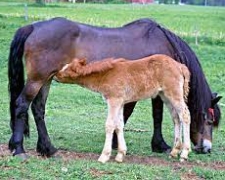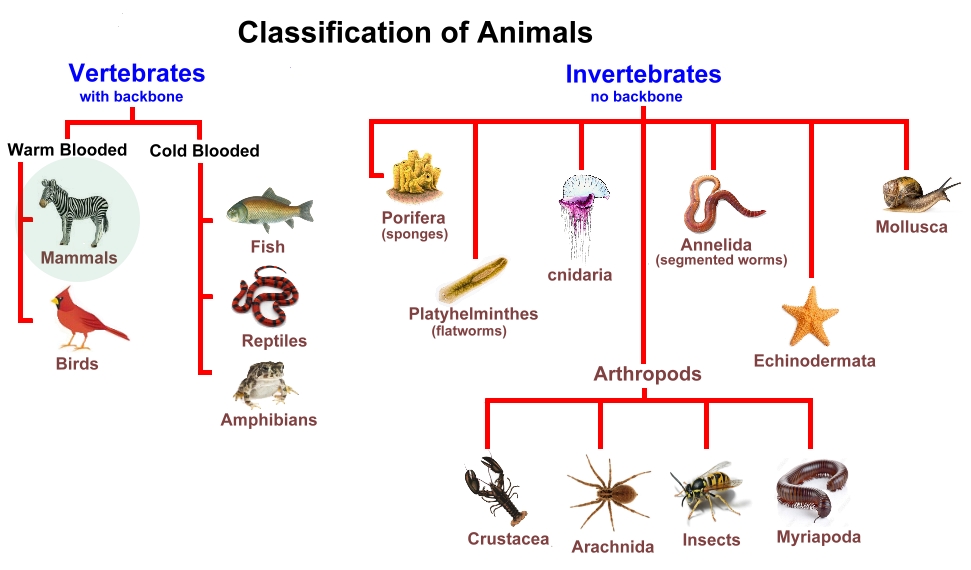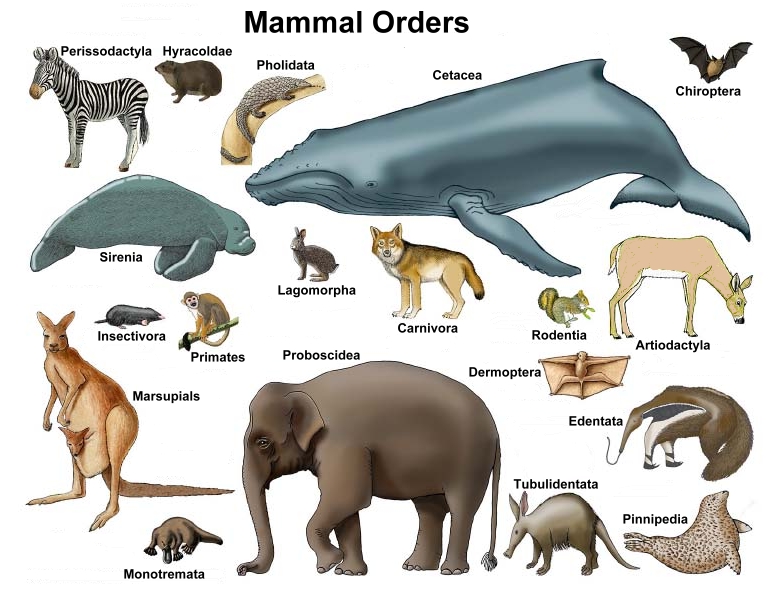  According to the taxonomy of living things, the phylum chordata (animals with backbones) is divided into five classes: fish, amphibians, reptiles, birds and mammals.
According to the taxonomy of living things, the phylum chordata (animals with backbones) is divided into five classes: fish, amphibians, reptiles, birds and mammals. Mammals include humans and all other animals that are warm-blooded, vertebrates, and with hair. They feed their young with milk from special mammary glands of the mother, and have a more well-developed brain than other animals. Hair is a mammalian feature, although not shared by all; in many whales, for example, it has disappeared. The mammalian lower jaw is hinged directly to the skull, instead of through a separate bone. A muscular diaphragm separates the heart and the lungs from the abdominal cavity. Other features of mammals:

  

 Mammals can be found in biomes all around the world, on all continents except Antarctica. Mammals are said to have a wider distribution than any other single class of animals, with the exception of certain arachnids and insects. This is due in large part to the ability of mammals to regulate their body temperatures in hot, arid, and severely cold environments.  Mammals have tremendous diversity in their form and habitat. They range in size from a bat weighing less than a gram and tiny shrews weighing just a few grams, to the largest animal that has ever lived, the blue whale, which reaches a length of more than 30 metres and a weight of 180 metric tons. Every major habitat has been exploited by mammals that swim, fly, run, burrow, glide, or climb.  There are more than 6,631 species of mammals, arranged in about 125 families and as many as 27–29 orders. The rodents (order Rodentia) are the most numerous of existing mammals, in both number of species and number of individuals, and are also one of the most diverse. In contrast, the order Tubulidentata is represented by a single living species, the aardvark. Our thanks to Kane Rosario, the Assistant Outreach Manager at World Animal Foundation who provided an updated figure for the number of species of mammals. Visit their site here. Domesticated mammals are so entwined with human history that it is almost impossible to assess their value in economic terms. Humans have, over the course of hundreds of thousands of years, depended on other mammals for food and clothing. Domestication of mammals helped to provide a source of protein for ever-increasing human populations and provided means of transportation and heavy work. Today, domesticated strains of the house mouse, rabbit, guinea pig, hamster, gerbil, and other species provide much-needed laboratory subjects for the study of human-related physiology, psychology, and a variety of diseases from dental caries to cancer. The care of domestic and captive mammals is the basis for the practice of veterinary medicine. Wild mammals are a major source of food in some parts of the world, and many different kinds, from fruit bats and armadillos to whales, are captured and eaten by various cultural groups. In addition, hunting, primarily for sport, of various rodents, lagomorphs, carnivores, and ungulates is a multibillion-dollar industry. In the United States alone, for example, it is estimated that more than two million deer are killed annually by licensed hunters. The presence of wild furbearing mammals, particularly beavers and several species of marten and fisher, was one of the most important motivations for the opening of the American West, Alaska, and the Siberian taiga. Ranch-raised furbearing animals such as mink, fox, and chinchilla directly and indirectly contribute many millions of dollars in revenue each year in North America alone. Some mammals have and continue to be in conflict with human activities. Rats and mice occur throughout the world and each year cause substantial damage and economic loss. Native carnivores such as wolves sometimes prey on domestic herds. Mammals are also important agents of transmission of a variety of diseases that afflict man, such as plague, tularemia, yellow fever, rabies, leptospirosis, Lyme disease, and hemorrhagic fevers such as Ebola, and Rocky Mountain spotted fever. The annual total cost resulting from mammal-borne diseases that affect humans and domestic animals is incalculable. Many large mammals exist today mostly only in parks, protected areas and zoos; many are in danger of extinction. Their plight is receiving increased attention from a number of conservation agencies. The International Union for Conservation of Nature (IUCN) reported that nearly one-quarter of all mammals are at risk of extinction. The single greatest threat to these mammals is the continued destruction of their habitat; however, many species are also aggressively hunted. |